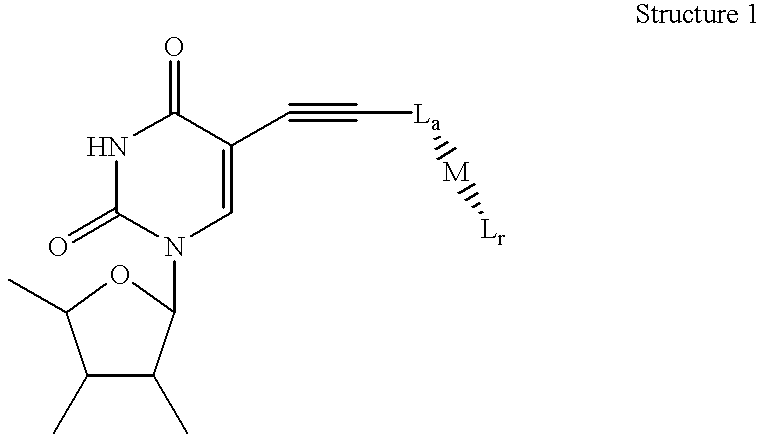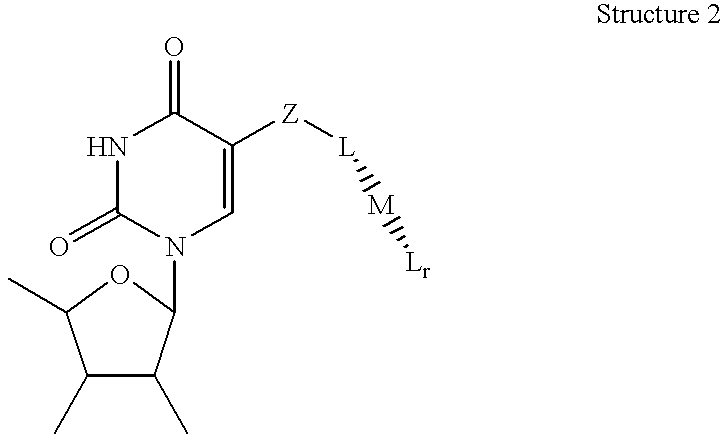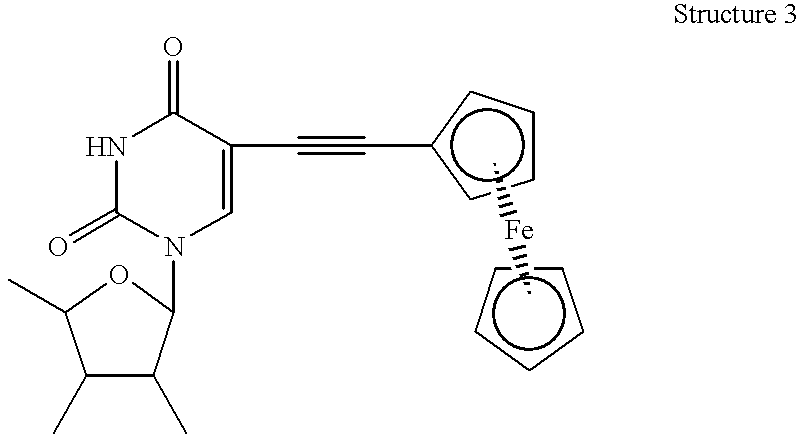Amplification of nucleic acids with electronic detection
a nucleic acid and electronic detection technology, applied in the field of nucleic acid detection, can solve problems such as significant increase in the number of target molecules
- Summary
- Abstract
- Description
- Claims
- Application Information
AI Technical Summary
Benefits of technology
Problems solved by technology
Method used
Image
Examples
example 1
Synthesis of Nucleoside Modified with Ferrocene at the 2′ Position
[0486]The preparation of N6 is described.
[0487]Compound N1. Ferrocene (20 g, 108 mmol) and 4-bromobutyl chloride (20 g, 108 mmol) were dissolved in 450 mL dichloromethane followed by the addition of AlCl3 anhydrous (14.7 g, 11 mmol). The reaction mixture was stirred at room temperature for 1 hour and 40 minutes, then was quenched by addition of 600 mL ice. The organic layer was separated and was washed with water until the aqueous layer was close to neutral (pH=5). The organic layer was dried with Na2SO4 and concentrated. The crude product was purified by flash chromatography eluting with 50 / 50 hexane / dichloromethane and later 30 / 70 hexane / dichloromethane on 300 g silica gel to afford 26.4 gm (73%) of the title product.
[0488]Compound N2. Compound N1 (6 g, 18 mmol) was dissolved in 120 mL toluene in a round bottom flask. zinc (35.9 g, 55 mmol), mercuric chloride (3.3g, 12 mmol) and water (100 mL) were added successivel...
example 2
Synthesis of “Branched” Nucleoside
[0493]The synthesis of N17 is described, as depicted in FIG. 11A.
[0494]Synthesis of N14. To a solution of Tert-butyldimethylsily chloride (33.38 g, 0.22 mol) in 300 mL of dichloromethane was added imidazole (37.69 g, 0.55 mol) . Immediately, large amount of precipitate was formed. 2-Bromoethanol (27.68 g, 0.22 mol,.) was added slowly at room temperature. The reaction mixture was stirred at this temperature for 3 hours. The organic layer was washed with water (200 mL), 5% NaHCO3 (2×250 mL), and water (200 mL). The removal of solvent afforded 52.52 g of the title product (99%).
[0495]Synthesis of N15. To a suspension of adenosine (40 g, 0.15 mol) in 1.0 L of DMF at 0° C., was added NaH (8.98 gm of 60% in mineral oil, 0.22 mol). The mixture was stirred at 0° C. for 1 hour, and N14 (35.79 gm, 0.15 mol) was added. The reaction was stirred at 30° C. overnight. It was quenched by 100 mL ice-water. The solvents were removed under high vaccum. The resultant f...
example 3
Synthesis of Triphosphate Nucleotide Containing an ETM
[0499]The synthesis of AFTP is described.
[0500]N3 (1.00 g, 1.97 mmol) was dissolved in 15 mL of triethyl phosphate, followed by adding diisopropylethylamine (0.69 mL, 3.9 mmol). While the mixture was kept at 0° C., and phospherous oxychloride (0.45 g, 2.93 mmol) was added. The reaction mixture was stirred at 0° C. for 4 hours, then at 4° C. overnight. Bis(tributyl)ammonium phosphate (3.24 g, 5.91 mmol.) was added, and the reaction mixture was stirred at 0° C. for six hours, and at 4° C. overnight. The white precipitate produced in the reaction was removed by filtration. The filtrate was treated with water (20 mL), and yellow precipitate was formed. The precipitate was filtrated and was dried under high vacuum to afford 0.63 g of the title product as yellow solid.
PUM
| Property | Measurement | Unit |
|---|---|---|
| Electrical conductor | aaaaa | aaaaa |
| Thermal stability | aaaaa | aaaaa |
Abstract
Description
Claims
Application Information
 Login to View More
Login to View More - Generate Ideas
- Intellectual Property
- Life Sciences
- Materials
- Tech Scout
- Unparalleled Data Quality
- Higher Quality Content
- 60% Fewer Hallucinations
Browse by: Latest US Patents, China's latest patents, Technical Efficacy Thesaurus, Application Domain, Technology Topic, Popular Technical Reports.
© 2025 PatSnap. All rights reserved.Legal|Privacy policy|Modern Slavery Act Transparency Statement|Sitemap|About US| Contact US: help@patsnap.com



